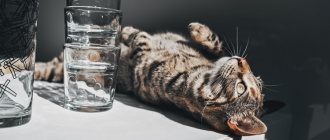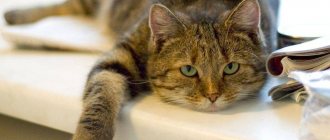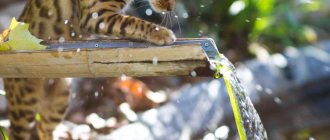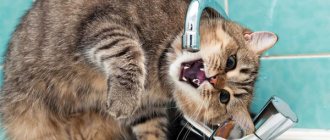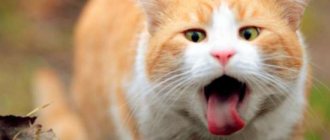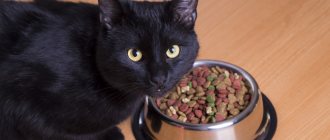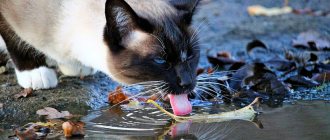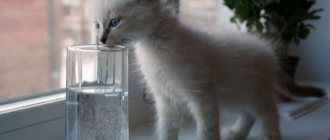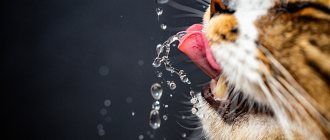If a cat does not drink water, there may be natural or pathological reasons for this. Lack of thirst leads to dangerous diseases - urolithiasis, blood thickening, dehydration, and kidney failure. The owner should know which symptoms are dangerous and when to take the pet to the veterinarian. A specialist will be able to determine the cause of the lack of thirst and prescribe treatment.
According to researchers, the domestic cat, as a representative of predators and the heir to the instincts of wild animals, does not drink water in the place where it feeds, since large cats ate driven game in one direction and went to the other to drink water.
Reasons why a cat doesn't drink water
Of course, water is essential for the health of our cat and should be consumed daily in sufficient quantities, but this does not always happen. Naturally, cats do not drink because they are accustomed to consuming the necessary liquid directly from their prey, which is usually rodents, birds and even lizards with a water content of about 70%. But cats that live indoors do not have the opportunity to hunt and depend on food provided by their owners. I think this is very common with around 8% water content as a result of the manufacturing process.
© shutterstock
Comparing natural prey with this menu, we will understand that the cat must swallow liquids in much larger quantities than she is used to. Consequently, health problems may arise and it is important that we encourage our cat to drink. Therefore, it is normal for us to worry if we notice that our cat is not drinking water. In this sense, one of the most common reasons is that the cat hunts and feeds if it has access from outside. If not, then the reasons may be:
- The cat doesn't like her drinking fountain. In this case, the cat can drink water from other sources, such as a tap.
- The drinking fountain is located too close to the tray. Cats are animals that prefer their space to be well-partitioned, so they may refuse to drink water if their drinking fountain is too close to an area intended for relief.
- Their diet is wet and they already meet their water needs.
- The water is dirty and the cat prefers not to drink. These animals are also known for their neatness, so they refuse to drink water that they consider bad.
- There are several cats, and one or more are preventing the others from drinking water. If your cat has stopped drinking water and you recently adopted another cat, she may be using her resources.
- The cat has a medical condition that causes him to drink less water.
Since he may have health problems, it is important to go to the vet for a checkup. If this reason is excluded, how to teach a cat to drink water? How much water does a cat need to drink per day? In the following sections, we explain what steps we can take to get your cat to drink more, how much water to drink, and what to do if she doesn't drink enough water.
Liquid consumption rate
When feeding an animal with dry food, it is necessary to provide it with constant access to clean water. On average, a cat should drink about 100-150 ml per day, depending on the weight of the pet. Particularly obese cats need more fluid, kittens need less.
You can accurately calculate the amount of water based on the frequency of supply. On average, one part of dry food should be three parts of water per day. If, in addition to dry food, the animal consumes canned cat food, the amount of water may decrease, since such food is wet and covers half of the daily fluid intake.
We recommend the article: Why does a cat have dirty ears?
Benefits of water for cats
Good hydration promotes proper functioning of the kidneys and urinary system. In addition, it prevents the formation of crystals as it increases the dilution of urine and if you go to the sandbox more times, it remains in the bladder less time, which is another factor that contributes to sedimentation.
If water intake is important for healthy cats of any age, it is even more important for those with urinary or kidney problems. In these cases, you should not only follow the advice outlined in the following sections, but also take the cat into the hands of a veterinarian.
Why may a kitten refuse food?
Most of the reasons why a baby does not want to eat are not associated with painful conditions. There may be several reasons for refusal.
Stress. If a baby is torn away early from his mother cat or transported from a nursery, he will initially feel uncomfortable in his new home. Sometimes, when changing residence, the kitten completely stops eating and drinking, then for 2 days he never goes to the toilet. This is very dangerous because it causes dehydration and intoxication of a still fragile body.
During periods of stress, you need to show care and attention towards the new resident, take him in your arms. New food. Previously, the kitten received food from its mother, it ate milk
The loss of milk manifests itself as a shock to the kitten’s body. They removed him from the cat early. The kitten simply cannot learn to eat food because it was torn away from its mother early. In this case, he needs to be fed with an analogue of cat's milk, which is sold in pharmacies. If you can’t buy it, goat will do. Dirty dishes often become a factor in refusal to eat food not only for kittens, but also for adults. Also, the animal will not like plastic dishes with an unpleasant odor. Worms and parasites. This causes poor appetite or complete refusal to eat. The kitten loses weight, its fur deteriorates, diarrhea and vomiting occur. In this case, the help of a veterinarian is necessary.
Important! If, in addition to poor appetite, the baby exhibits additional symptoms such as lethargy, diarrhea, and bad breath, then you should immediately go to the clinic. You can’t risk the animal’s health
Cat's milk is an essential food during a kitten's early life. When it reaches 3-4 weeks, you can introduce simple food into the diet - cottage cheese, milk, porridge. You should always watch your baby and his reaction to foods. Then the kitten will grow up healthy, beautiful and well-groomed.
Kittens are born small and completely helpless, then at first all the difficulties fall on the shoulders of the mother cat, but then 3 weeks passed and she needed the help of her owner in order to cope with these little fidgets. At three weeks of age, babies begin to move, they already see, hear, and go to the toilet on their own. Now the owner will have more problems related to caring for this wonderful creature. In addition to the question of how to protect the little fidget, a person will have another question: how to teach a kitten to eat on its own. In our article we will talk about at what age he begins to eat on his own, and how his diet needs to be changed.
How to offer water to a cat?
When it comes to drinking, cats can be something special. The first step to getting your cat to drink water is, of course, to make sure she has clean, fresh water available 24 hours a day, and it should be changed several times a day. It is recommended to leave several drinking bowls in different parts of the house so that you always have quick access to them. In addition, if there is more than one cat in the house, it is good that they have their own bowls so that everyone can drink in peace without preventing others from accessing this resource.
On the other hand, cats like to distribute their home into different spaces. This means keeping the water separate from the litter box, play area, bed, or other resting surfaces. It is also not good that it is attached to the feeder. In addition, it is necessary to choose a suitable drinking bowl. Sometimes we may notice that our cat does not drink water from the bowl because it is too closed, so that its whiskers rub against the edges, which creates discomfort. Therefore, you should choose wide gutters in which this contact does not occur. The material is also important. Plastic can change over time, so it is recommended to choose stainless steel or ceramic, which are also easy to clean.
Fountains for cats
Sources for cats deserve a separate section. Many of them instinctively reject stagnant water, and we will sometimes see them put their foot in the drinking bowl to move it before they start drinking. Others jump into the tap water as soon as they realize we're opening it, or even open it themselves.
In these cases, cat fountains are a good option because they keep the water moving continuously, which encourages them to drink.
As a recommendation, leave her drinking fountain running at first until she adjusts to using the new fountain.
© shutterstock
Goat and sheep milk
It must be admitted that goat and sheep milk is less allergenic than cow milk. If an adult cat has an intolerance to cow's milk, but you really want to treat it with milk, then this will be a good replacement.
As for kittens, ruminant milk does not cover their nutritional needs. Proteins and fats will not be enough, and, as a result, a kitten fed with goat's or sheep's milk will grow and develop slowly.
The lactose content in the milk of goats and sheep is higher than that of cats. Although kittens produce lactase, it is designed for cat milk.
Diet with lots of water
If you feed your cat food, it is likely that although she will drink, she will not do so in sufficient quantities to meet her needs. This is why it is recommended to at least offer him a so-called mixed diet, which is nothing more than feeding and wet food, which is canned cat food. So, if you are wondering how to hydrate a cat that doesn't want to drink water, this type of diet has the answer.
Thus, we must calculate the amount of dry food and wet food that our cat needs daily and offer her, for example, half of each diet to create her menu. It's important to take the time to calculate otherwise if we overdo it we risk causing weight gain.
Both products should be given separately and it is recommended to offer them in small quantities several times a day. This is a feeding method that is closer to its natural behavior, and it has also been proven that eating more frequently encourages a cat to drink more times.
On the other hand, remember to choose a quality diet. Spend some time comparing the formulations and ingredients of different brands. There are good options for every budget. It is important that the food you choose is tailored to your cat's stage of life, and if she has any medical conditions, you provide her with a special diet prescribed by your veterinarian for both dry and wet food. Otherwise, the desired positive effects would not be achieved.
Finally, you can feed your cat homemade food if the menu is designed by a cat nutrition expert. Otherwise, nutritional deficiencies and health problems may result.
The main reasons for refusing water
Possible reasons for a cat refusing water may be:
- the cat receives all the necessary volume of liquid with wet food;
- the cat found a source of drinking in another place unknown to you in the apartment or on the street, for example, in the bathroom or in a puddle while walking;
- contaminated water that has a foreign odor or taste;
- The water container is dirty or has a strong foreign odor;
- change of water source;
- the water is very cold;
- high water hardness;
- proximity of the water container to the toilet;
- change of environment (moving to another home or to another area);
- increase in humidity and (or) decrease in room temperature;
- animal disease;
- mechanical obstructions (such as a stuck bone) or trauma in the mouth;
- postoperative period.
In any case, a cat’s refusal to drink water for 2 days is a good reason to contact a specialist for examination and testing.
What to do if your cat doesn't drink water?
If you offer your cat a diet with a good supply of water, it is likely that you will find that she does not drink much, but her needs will generally be covered. On the other hand, if the cat is only eating, I think, and although you followed the previous advice, you may be sick and dehydrated. Check this by gently pulling the skin at the withers. If it takes time to return to its original position, it indicates dehydration and we should contact a veterinarian. Also if we detect other symptoms or if the cat is still not drinking.
Likewise, instead of wondering why your cat isn't drinking water, make an appointment with your veterinarian. Kittens and older cats are especially susceptible to dehydration, and their condition may worsen within a few hours. Therefore, in any case, if your cat has stopped drinking water, you should call the vet, regardless of whether it happens from day to day or you notice that he is drinking less. In addition, on the contrary, drinking a lot of water is also a symptom of the disease.
Article Author: Catit - Animal Expert We are cat lovers. Catit has been combining a passion for cats with innovation in products designed specifically for them for many years. They say a house with cats is a house with magic, and we couldn't agree more. Our goal as cat product manufacturers has always been to create completely effective and 100% engineered and engineered designs for our cats. Catit not only meets all your needs, but also offers unique features that provide great value.
What are the consequences of lack of fluid?
If an adult cat or small kitten does not eat or drink, the pet can become seriously ill, since dehydration can lead to the following ailments:
Against the background of this condition, blood clots may form in the animal as the blood becomes thicker.
- Urolithiasis disease. Cats have concentrated urine, so if the cat begins to refuse fluid, this leads to the formation of struvite. If stones block the ureters, urine is not excreted from the body. This is dangerous due to uremia and general intoxication, which is dangerously fatal.
- Blood thickening. When a pet doesn't like to drink, it leads to viscosity and poor circulation. The condition increases the load on the heart, reduces the functionality of the liver and kidneys, provokes oxygen starvation of tissues, the formation of blood clots, which ends in death.
- Kidney failure. It occurs in acute and chronic forms. It is characterized by suppression of kidney function, accumulation of harmful substances in the body, and increased blood pressure. The most susceptible to pathology are British, Maine Coon, and Persian cats.
- Dehydration. This is a critical lack of water in the animal’s body, in which all organs and systems suffer. If a pet does not drink for more than 2-3 days, there is a high probability of irreversible changes and death.
What should a water bowl be like?
You should immediately realize that bowls made from cheap, low-quality plastic often have an unpleasant odor. A person may not feel it, but for cats this aroma will be quite obvious, and they may refuse to drink from such dishes. The same can be said about metal bowls, the smell of which also very often does not cause much delight in cats.
Glass and ceramic containers, large and wide, are best suited for watering cats. In such bowls, water remains fresh for a longer period, and glass and ceramics are odorless.
Symptoms of dehydration
- Sunken or very dry eyes;
- Dry skin or skin with less elasticity. When the skin is pinched, it does not immediately recover;
- Dry mouth.
- Capillary refill time. When pressing on the gums, it takes time for them to restore their red natural color.
- Increased body temperature and increased heart rate;
- Dyspnea.
If you have these symptoms, your pet should be taken to the veterinarian immediately to find out the cause.

